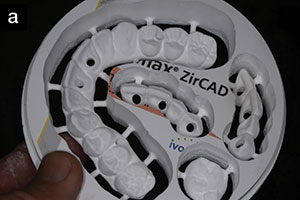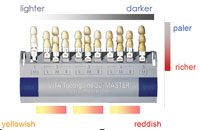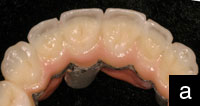Many practitioners believe denture cases are decreasing in the United States. This fact is attributed, in part, to improvements in preventive dental care and increased access to care. However, as the population ages, a significant percentage of adults will remain who require dentures. According to information from the Centers for Disease Control and Prevention, in 1991, 33.6 million individuals needed one or two complete dentures. In 2020, this number is expected to reach 37.9 million.1
We as dental professionals must remember that many of these patients will be first-time denture wearers and may perceive dentures as a quick and easy solution to edentulism. Often we see patients who begin the denture process thinking they will leave the office after their first visit, dentures in hand. From a professional standpoint, we have the opportunity to help manage our patientsÌ expectations by educating them about the entire denture process. This includes not only the adjustments patients need to make in their daily routines, but also the time and collaboration required to ensure that dentists and dental laboratories produce a quality final deliverable product. From the initial visit until the final fitting, complete and frequent communication with the patient about the necessary steps in the proper denture process can help eliminate multiple adjustments down the road, will keep your patient aware of what to expect throughout the process, and can help ensure higher levels of denture success.
There is great benefit in taking the time to teach patients and caregivers about the importance of aftercare, that is, proper care and maintenance of dentures and regular follow-up dental visits. In fact, studies have found that while technical considerations are important, understanding the patientÌs needs and being able to communicate effectively with him or her is more important.2 WeÌve found that when patients understand the process and timeline of making dentures from the start, they are more comfortable and confident with their dentures as a whole.
DEFINING A DENTURE CARE TIMELINE
Step One: Managing Expectations
Beginning at the first patient visit, dental professionals can help make new denture patients more comfortable by acknowledging that it takes time and patience to adjust to life with dentures. Patients should understand that denture placement involves more than just the physical transformation. Once patients receive their new teeth, a variety of changes occur, including the following:3
• clearer speech
• ability to eat a wider variety of foods
• improved appearance
• improved confidence in social situations and personal relationships.
Although patients will certainly look forward to these benefits, it is important to manage their expectations and ensure they understand that these benefits may not be experienced immediately.
Step Two: Making a Good Impression
As dental professionals, we understand the importance of a good impression in the overall success of a denture program. But do our patients understand that this impression-making process may involve more than one visit? It is important to educate your patients from the start that several steps must be taken to ensure a secure fit. Measurements will be taken, and preliminary, final, and master casts will be made. This process clearly has the patientsÌ best interests in mindÛit will lead to the best fit and function of their dentures and will help assure them that they are receiving the best possible care.
Step Three: Choosing New Teeth
Patients should feel empowered to make decisions during each step of the decision-making process. Patients will appreciate that they may decide on the shape, size, and shade of their teeth, and, of course, have the overall approval responsibility. In fact, an often-overlooked advantage of complete dentures is the ability to replace lost teeth and associated hard and soft tissues with little impediment from existing structures. From the patientsÌ perspective, this means they can have teeth of ideal color, shape, and position, and perfect gingiva to match,2 which is often a big psychological advantage to them. However, since patients may be uncertain about what shape, size, and shade best matches their natural teeth, dentists can make the process easier by suggesting that a family member, friend, or caregiver be involved in the selection process.
Step Four: Initial Fitting of the New Dentures
The initial fitting step may be a very anxious time for the patient. At this time, it is important to explain fully the tooth extraction process as well as the try-in procedures for the denture. Additionally, it is important to explain that the dentures will be placed in the mouth, and in certain cases, adjustments will need to be made to ensure optimal fit, which may necessitate an immediate denture. An important recommendation is that patients keep their immediate dentures as a spare if their final dentures require repair.
Step Five: Adjustment, Rebasing, and Relining
Finally, stressing the importance of ongoing follow-up care is critical. While many patients may view the fitting to be the end of the denture journey, in fact, patients must understand that they need to schedule periodic follow-up visits to ensure proper fit and function. Over time, physiological changes will occur within the mouth. Patients need to know that these changes are normal, and periodic adjustments to the denture may be necessary to ensure proper fit and comfort. In addition, rebasing and relining may be necessary. Because adjustments will take time for the dentist and laboratory to complete, patients may use their immediate dentures while adjustments are being made.
Step Six: Aftercare
Although edentulous patients no longer have their natural teeth, regular visits to the dentist are necessary. Patients usually visit their dentist when they are concerned with fit and function, or when their dentures require repair. However, as with dentate patients, edentulous patients need preventive oral care. When discussing a denture timeline with the patient, it is essential to address the need for regular future visits.
Ongoing denture success requires regular professional care. Dentists should discuss potential future concerns, such as the following:4
• difficulty chewing food
• cheek biting
• speaking difficulties
• red/inflamed gingiva
• denture discomfort
• damage to the denture
• physiological changes within the mouth.
Patients should be advised to seek treatment if any of these occur. Patients also should be advised to see their dentist regularly for oral cancer screenings. Additionally, it is vital that dentists educate patients about proper care and maintenance of their dentures, including daily brushing and soaking.
Dentists may also discuss the benefits of using an adhesive to provide additional denture stability and added confidence while speaking and eating. Many patients report greater comfort and less food entrapment beneath the denture with the help of an adhesive.2 Additionally, the use of a denture adhesive (eg, Super Poligrip [Glaxo-SmithKline]) can help improve bite force up to 38%.5 Besides assisting patients in eating a wider variety of foods, increased bite force can contribute to something even more significant – patientsÌ overall confidence in their dentures.
If patients are aware of the need for regular professional care and maintenance, they are more likely to seek treatment. However, it is important to keep in mind that elderly patients may have limited access to transportation or may be restricted by limited mobility. Home visits may be an option for these patients. Dentists should discuss this with patientsÌ caregiver(s) at the start of the denture process. A home visit may instill patient trust and confidence, and may also provide a successful denture experience.
EDUCATIONAL TOOLS
Visual aids and handouts can help a patient better understand the denture-making and denture-fitting process. Examples of such materials may be accessed online at dental-professional.com. The site offers dental professionals several support materials that may be used with denture patients. When patients are aware of the timeline in advance, they can psychologically and emotionally prepare for the entire process. By demonstrating this extra care and concern, dentists may also find that patientsÌ families and caregivers soon become patients as well through referral.
DENTISTS AND DENTAL LABS: PARTNERS IN THE DENTURE CARE TIMELINE
Extensive communication between a dentist and a dental laboratory can simplify and expedite the entire denture process. Equally important to the dentist’s interaction with the patient is the dentistÌs interaction with the dental lab that will be making the denture(s). Dentists should feel comfortable consulting with the dental lab prior to the initial fitting. Labs often catch problems that can quickly be solved if there is clear and regular communication. This communication is vital to ensuring a high-quality final denture and avoiding frustration for the patient.
Dentists and labs may discuss study models over the phone and/or hold joint appointments with the patient to ensure that the patientÌs goals are properly communicated. By discussing schedules in advance and throughout the denture process, dentists and labs can prevent disappointing patients with unforeseen delays. If both dentists and labs are aware of the time required for each phase of the denture care timeline (including scheduled days off and even vacation), the process can be completed within a realistic timeframe.
CONCLUSION
Informed, educated patients are not only more confident, but more likely to experience denture success. By communicating a denture care timeline, dentists help patients know what to anticipate in the months prior to receiving their final dentures and how the end result will impact their future. Also, involving laboratories and caregivers can help ensure a quality denture procedure as well as encourage patients to return for regular visits, all of which can make a denture patient a patient for life.
References
1. Jahangiri L, Soni A. Making dentures work for your patients and practice. Dental Economics. 2004; 158-163.
2. Roessler DM. Complete denture success for patients and dentists. Int Dent J. 2003;53(5 suppl):340-345.
3. Rasner S. Switching chairs Ò learning to empathize with edentulous patients for successful treatment. Dental Products Report. February 2005; Available at: http://www.dentalproducts.net/xml/display.asp?file=2736&Result=nonqualify. Accessed June 16, 2006.
4. Data on file, GlaxoSmithKline.
5. Ghani F, Picton DC, Likeman PR. Some factors affecting retention forces with the use of denture fixatives in vivo. Br Dent J. 1991;171:15-21.
Dr. Heiberger is a 1985 graduate of New York University College of Dentistry and has been in private practice for 20 years. He can be reached at (732) 679-1133.
Mr. Acquaviva began his career in dental technology in 1985. Owner of Acqaudent Dental Laboratory since 1991, he manages a 6-person staff. Mr. Acquaviva became CDT certified with a specialization in removable prosthodontics in 1996 and earned a Valplast certification in 1998. He can be reached at (732) 656-3393.











